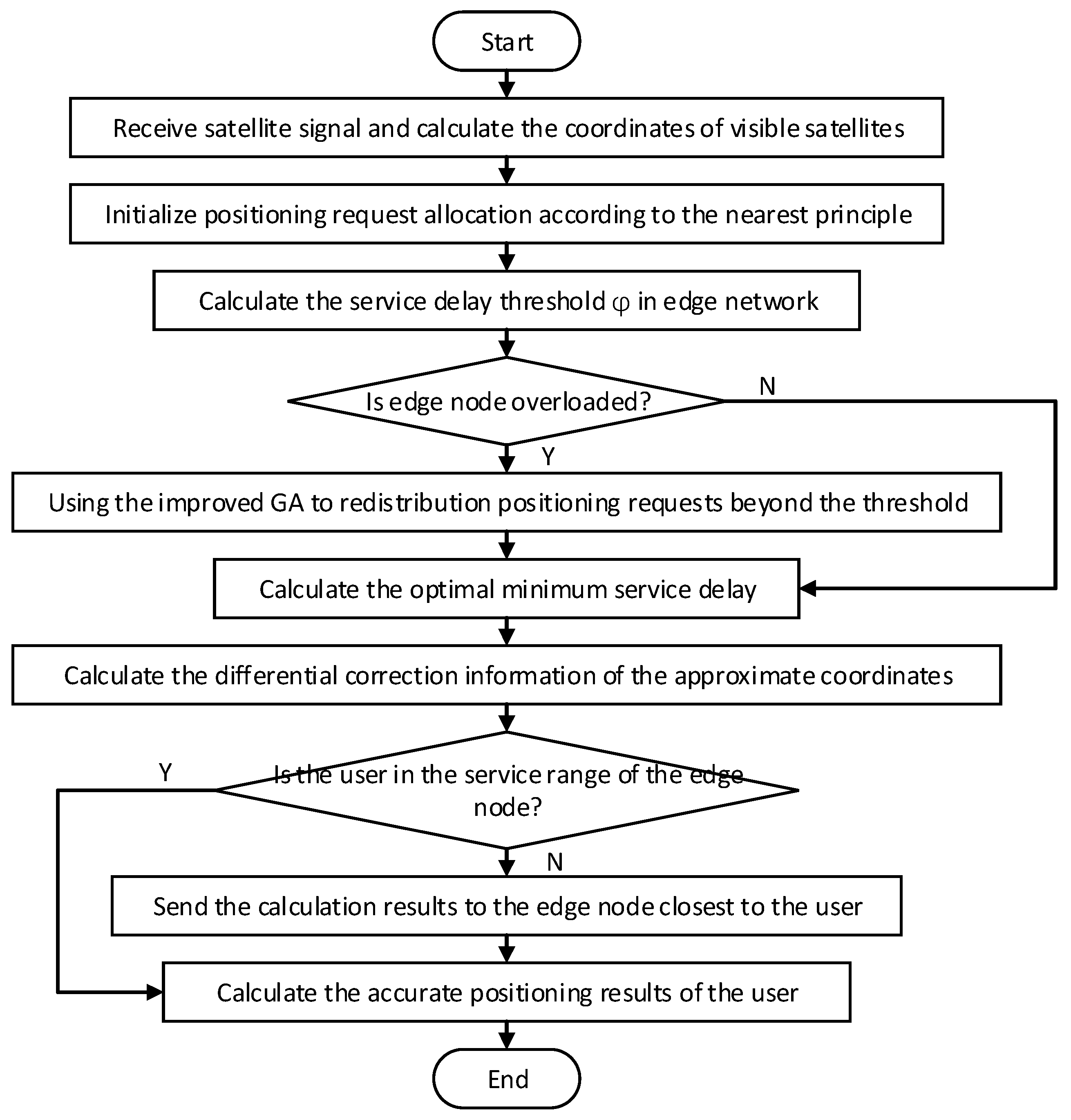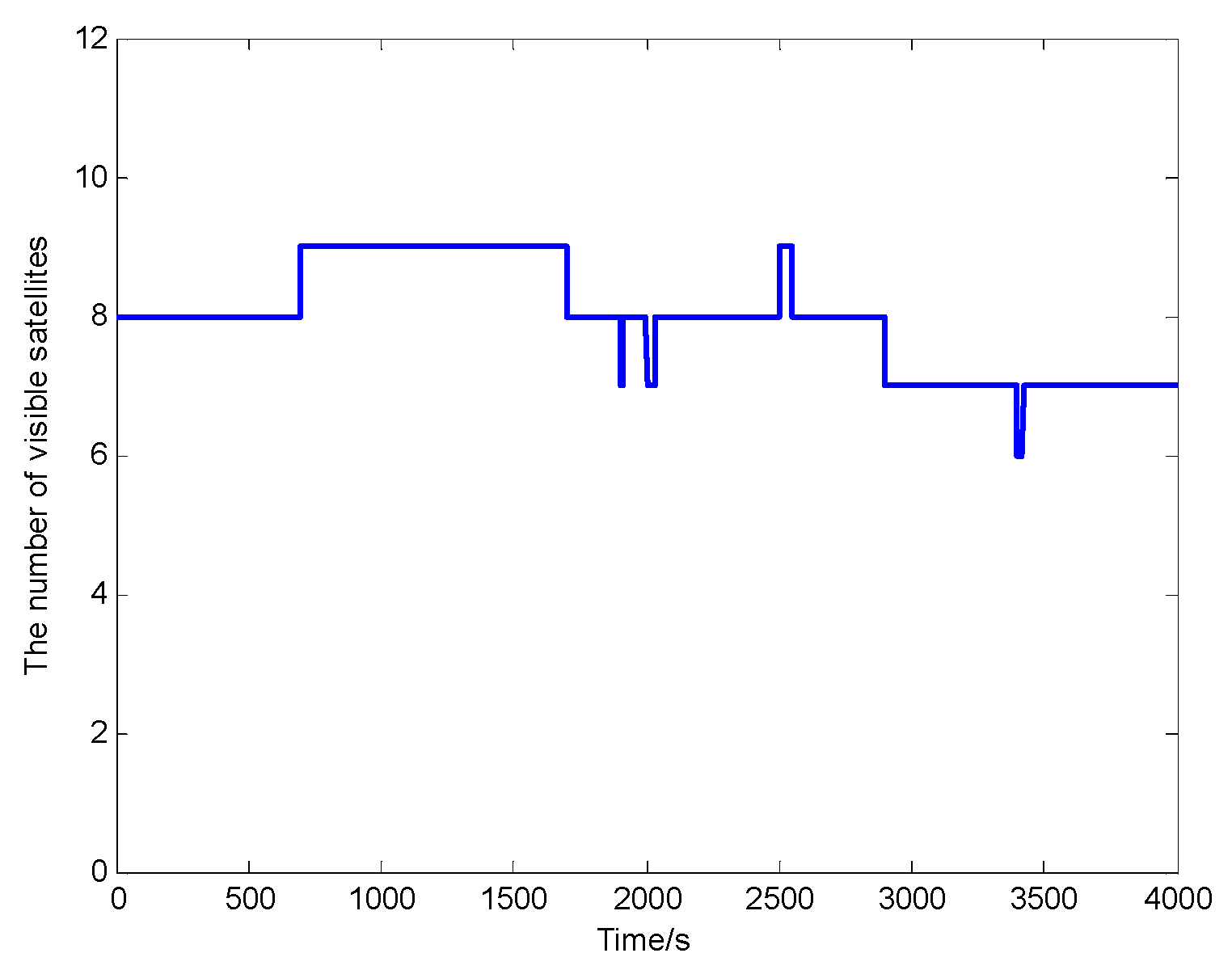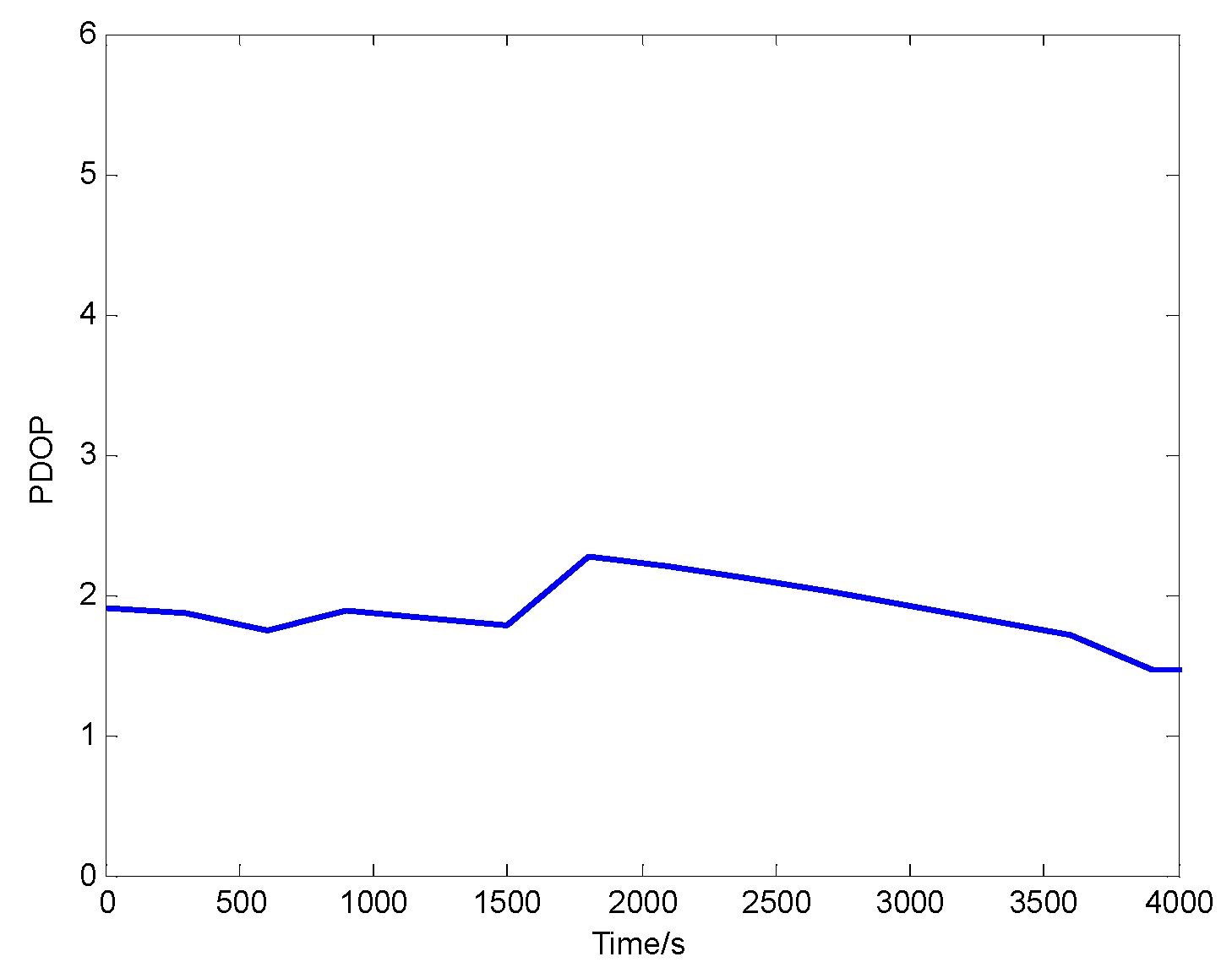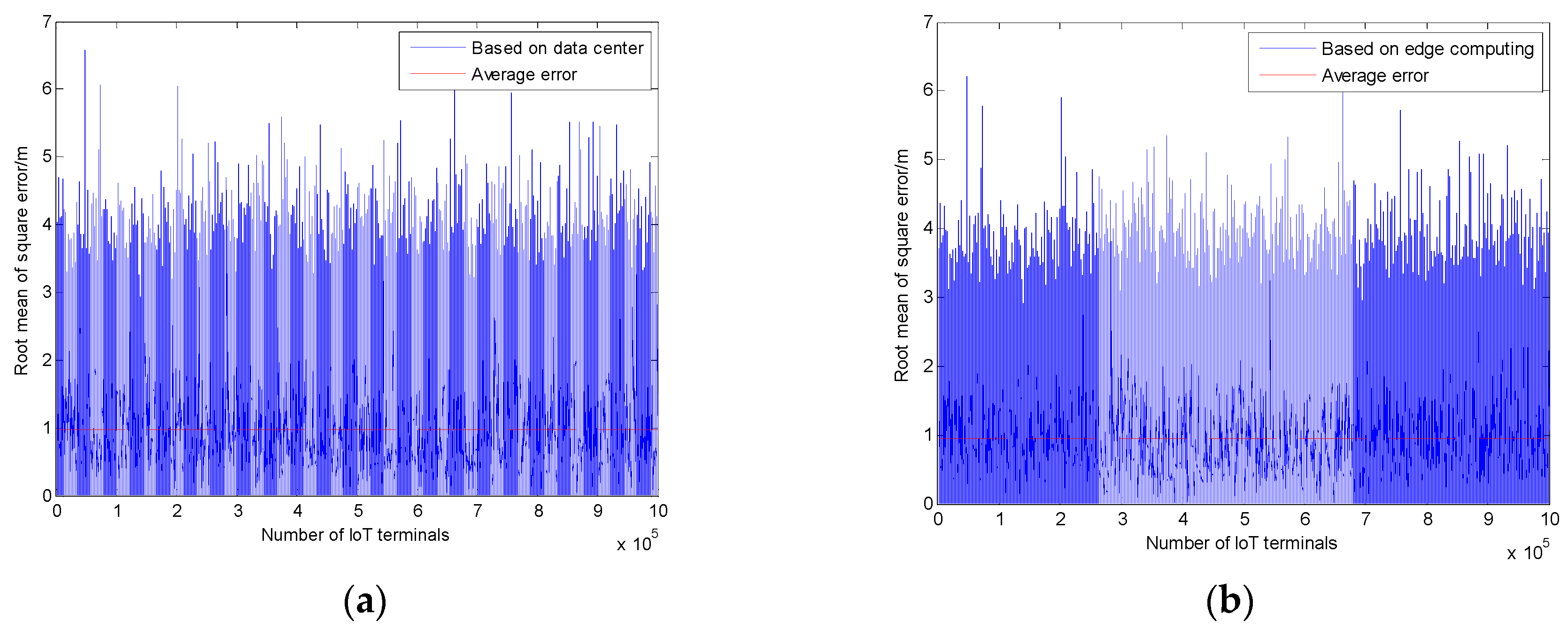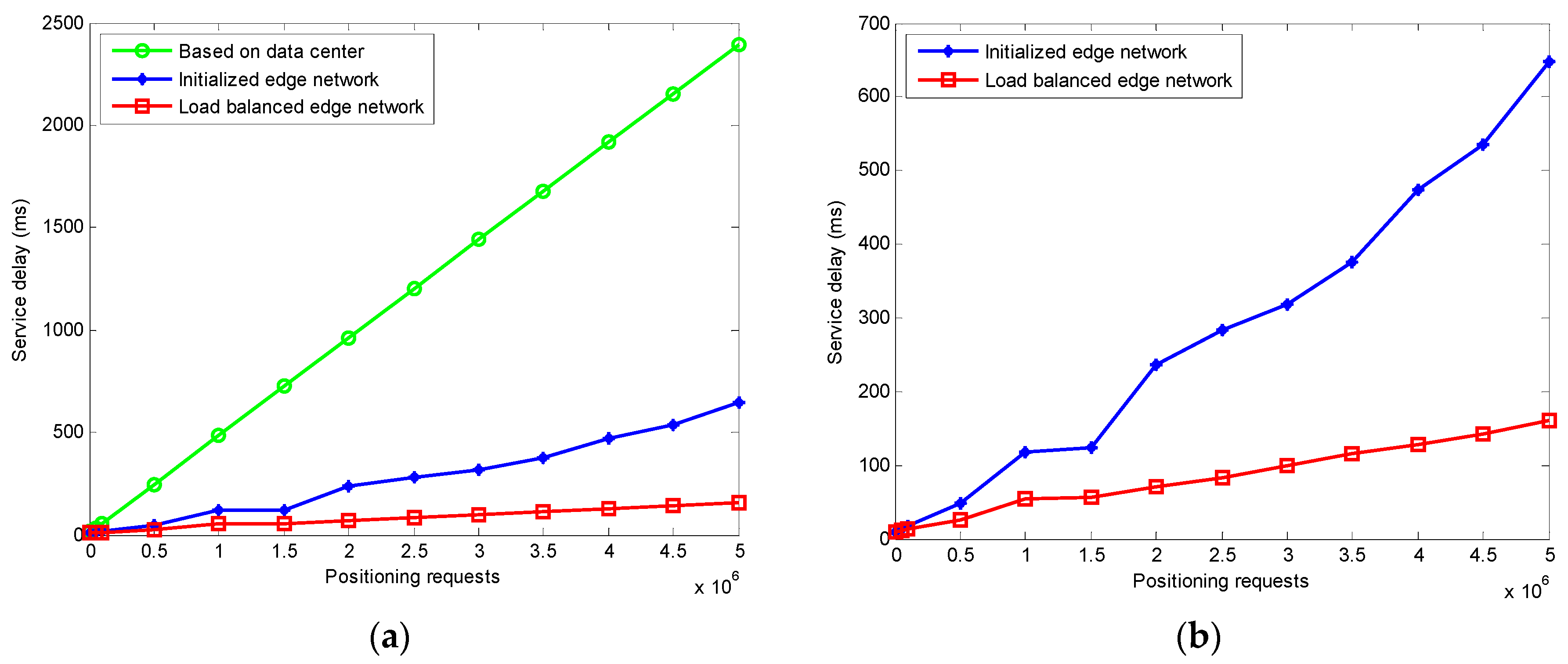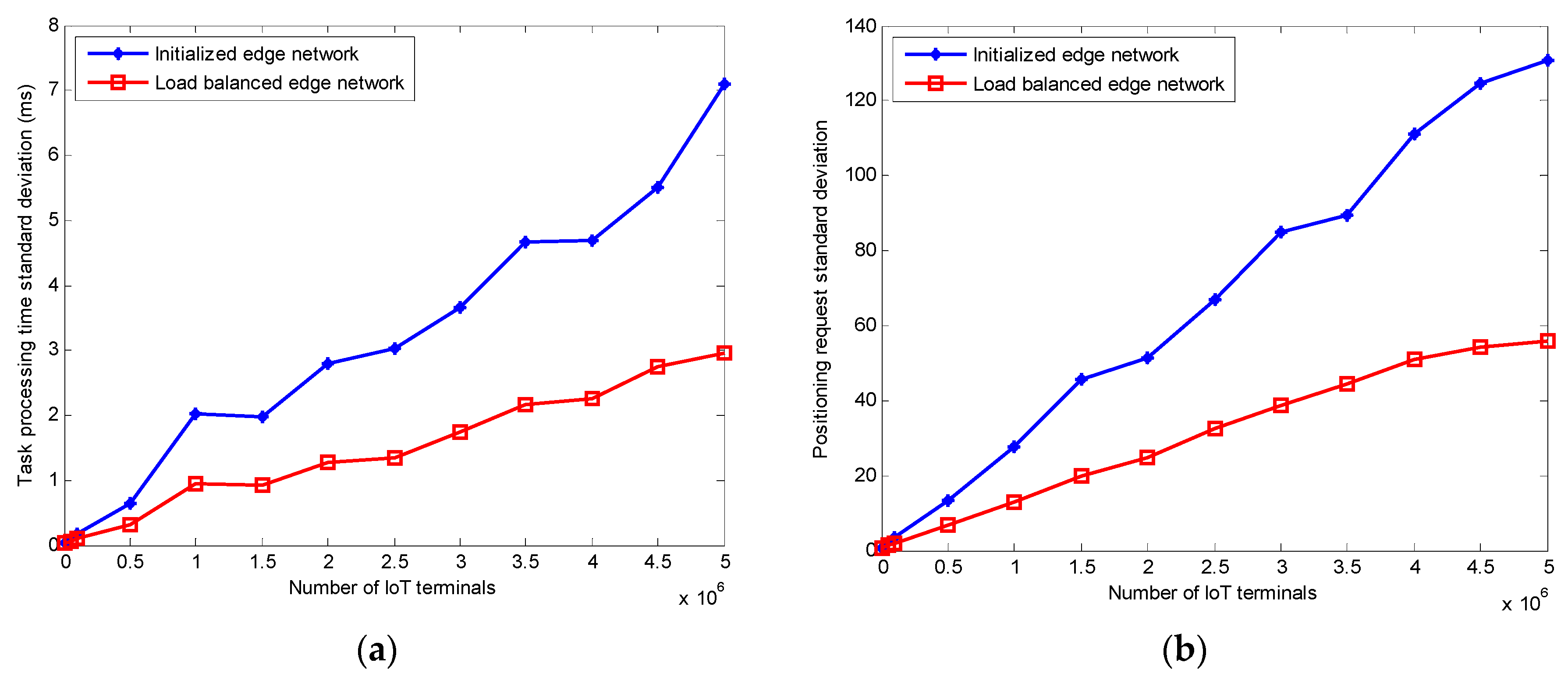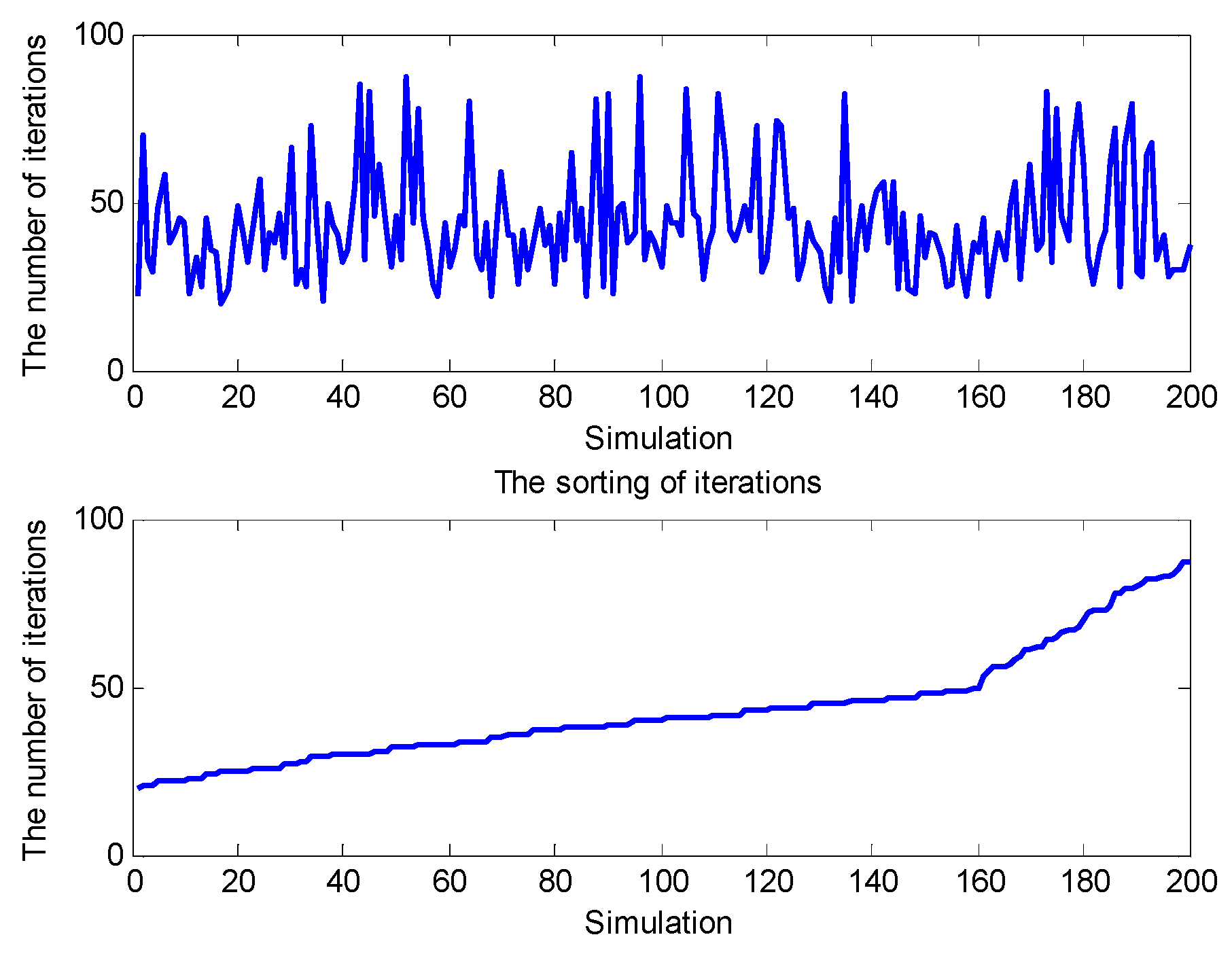3.1. Positioning System Architecture
The development of 5G communication technologies lays a foundation for the integration of navigation and communication. At the architecture level, navigation and communication equipment are integrated into one device. The base station in the cellular network is upgraded to serve as a reference station to observe navigation satellite signals. Combined with the existing and under construction continuous operation reference stations, the edge computing network is formed to provide navigation and positioning service for the IoT terminals. According to incomplete statistics, as of the beginning of 2017, China has established more than 6000 continuous operation reference stations.
Edge computing is a technology which conducts calculation at the network edge through a small data center closer to the terminals. The edge is the immediate first hop from the IoT device but not the IoT node itself, such as IoT gateways and base stations [
16,
17,
18,
19]. As an important part of the IoT, the base stations play a bridge role. It connects the IoT terminals and the cloud service. The continuous operation reference station situated at the IoT terminal side serves as an edge node which can provide high-precision positioning service with low latency, real-time interaction, mobility support, security, privacy for numerous deployed, and geographically dispersed IoT nodes.
The positioning system architecture based on IoT and edge computing has three layers, that is the cloud layer, edge layer, and things layer, shown in
Figure 2. The cloud layer includes a cloud server and data center. The edge layer includes a continuous operation reference station and base station network. The things layer includes IoT terminals and sensors. The edge layer and things layer participate in the positioning, whereas the cloud layer does not participate in the positioning, but only does the data collection, analysis, and processing work.
IoT node: The IoT node consists of sensors, devices, and terminals. The terminal initiates the positioning request. The GPS sensor measures the satellite signal and sends the measurement data to the edge node. The edge node calculates according to certain rules and policies. Finally, the terminal user obtains the positioning result.
Edge node: Edge node, which is equivalent to the small data center, can provide computing and storage resources to meet the positioning service requirements of various IoT terminals. The edge node can perform data preprocessing, simple data analysis and prediction, and send aggregated results to the cloud servers or IoT terminals. The edge nodes can communicate with each other, connect into the edge computing network, and carry out distributed computing. According to the approximate coordinate of the positioning terminal, the edge node dynamically generates the differential correction information to provide users with real-time and high-precision positioning results.
Cloud: The cloud uses the collected data by the IoT terminals. It can provide core service for the IoT terminals that include historical data analyses, data storage, and user behavior prediction. The location-based service can provide users with a more intelligent service based on the analysis results. The cloud service includes IoT terminal users tracking, configuration, analysis, reporting, authentication, and authorization service [
20].
The BDS positioning method based on IoT and edge computing aims to solve the high time delay problem of centralized computing in the data center. The base station is used as the edge node to calculate the differential correction information. When the terminal initiates the positioning request, the nearest edge node receives the positioning request and calculates the differential correction information, and sends the final result to the terminal for positioning calculation.
3.2. Positioning Method
The IoT terminals send positioning requests and each terminal will choose the nearest edge node for positioning calculation. This scheme does not consider the load balancing problem of edge nodes, which will lead to overload and delay the increase of some edge nodes. Additionally, it is difficult to respond to the sudden changes in terminal requests. In view of numerous IoT terminals and the uneven geographical distribution, it is easy to obtain the optimal load balancing results and minimize the service delay by formulating the link scheduling problems. The final differential correction information result is sent to the IoT terminal by the nearest edge node through the Internet, and the accurate positioning result of the terminal can be obtained in a short time.
The edge computing network can be represented by a weighted directional graph
, where
is the set of edge nodes, and
is the set of edge links. The edge link between
and
is
, and the communication delay of
is
. Each edge node is granted with computing ability
. The set of positioning request tasks is
. The service delay processed by the whole computing task
in the edge computing network can be expressed as Equation (7).
where
is the request capacity on the edge node
,
is the computation time on the edge node
. It can also indicate the waiting time of the task
.
is the transmission delay from the IoT terminal
to the nearest edge node
. If the task
is transmitted from edge node
to
and calculated at the edge node
, let
. Otherwise
, the task
is calculated at the nearest edge node
.
Considering the mobility of the IoT terminal and the limited-service scope of edge nodes, the computing result backhaul delay can be expressed as Equation (8).
where
is the service range of the edge node
. If the IoT terminal
is within the coverage of edge computing node
, the differential correction information is transmitted from the edge computing node
to the IoT terminal
. Otherwise, it is transmitted by the nearest edge node
to the IoT terminal
.
The service delay of positioning request in the edge computing network is equal to the maximum delay of all IoT terminals. To achieve the goal of minimum delay of positioning request, it is necessary to minimize the objective function
. Hence, the objective function of the task allocation problem can be formulated as follows.
When positioning tasks are assigned among the edge nodes, each positioning request should be allocated to the nearest edge node to minimize the service delay. Positioning task assignment is initialized by assigning all positioning requests to the nearest edge node.
Due to the uneven distribution of terminals’ geographical location and the different computing ability of each edge node, the initialization of positioning requests may cause overload of some edge nodes.
Reallocating the positioning requests on edge nodes to ensure load balancing can reduce the service delay of the whole system and maximize the throughput of the system. After the terminal positioning request is initialized, the average calculation time of the edge nodes is selected as the threshold. Then, the positioning requests exceeding the threshold
are reallocated. On each edge node, there is the capacity
used for the reallocated positioning requests. The task allocation problem can be represented as Equation (10).
Currently widely used task allocation algorithms include genetic algorithm (GA) and ant colony algorithm (ACA). The ACA is more complex and requires a longer running time, so it is not suitable for real-time positioning in this paper. The GA [
21] based on natural selection can solve large-scale combinatorial optimization problems and perform a parallel search. It has been proved to have robust search capabilities and could jump out local search space to achieve optimal solutions in global space. The best solution or secondary solutions are achieved by repeating employing three genetic operations, selection, crossover, and mutation. The improved GA proposed by this paper is used to redistribute positioning requests beyond the threshold
to ensure the minimum service delay of the system. In order to reduce the execution time of the GA, the first generation of the chromosome is initialized as a solution space on the edge node whose calculation time is lower than the threshold
. The hybrid selection method is used as a chromosome selection strategy. First, the top 20% best individuals are selected into the next generation directly, and set
. Then, the roulette algorithm is used as a selection operation for the remaining 80% individuals. The roulette algorithm is as follows.
(1) Calculate the fitness value of each individual .
(2) Calculate the probability of the selected individual
.
(3) Calculate the accumulation probability of an individual
.
(4) Determine whether an individual is selected. Generate the random number between [0,1]. If , select the individual 1. If , select the individual .
The crossover operator is the most important step in the genetic algorithm. It can determine the global search ability of the algorithm. The individuals selected by the selection operation have high adaptability. Randomly select two of the above-mentioned individuals for crossover operation. Judge the generated random number and crossover probability . If the crossover probability is large, the crossover operation is performed on two individuals to generate better individuals.
The mutation operation affects the diversity and local search ability of the population. In this paper, a single point mutation method is used to select one of the edge nodes randomly for gene mutation when the individual performs mutation operation. This randomness can enhance the local search ability of the algorithm, accelerate its convergence speed when the algorithm approaches the optimal solution, and reduce the immature convergence of the algorithm.
The above method reasonably assigns each positioning request to an edge node which calculates the differential correction information. It can effectively reduce positioning delay and provide real-time positioning services for terminals.
The load balancing degree of the edge computing network is measured by the standard deviation of task processing time (TSD) on each node [
22]. For a good and stable load balancing performance, TSD should be low.
where
is the edge node,
is the task processing time on the edge node
,
is the mean value of the time. Load balancing and service delay of the edge computing network affect the effectiveness of the task allocation algorithm.
The task allocation algorithm for the whole system is shown in Algorithm 1.
| Algorithm 1: The Task Allocation Algorithm |
| 1. | Input: List of terminals positioning requests and list of edge nodes |
| 2. | Output: Minimum service delay |
| 3. | Initialize |
| 4. | Calculate and for |
| 5. | For all in edge nodes, |
| 6. | Initialize |
| 7. | Initialize the first generation chromosome |
| 8. | While do |
| 9. | Calculate fitness of each chromosome in the previous generation |
| 10. | Calculate natural selection probability |
| 11. | Copy top 20% best individuals into next generation directly |
| 12. | The roulette algorithm is used to selection operation for the remaining individuals |
| 13. | Crossover operator |
| 14. | Mutation operator |
| 15. | Calculate the optimal allocation scheme and task processing time in this iteration |
| 16. | Generate the next generation chromosomes |
| 17. | End While |
| 18. | End For |
| 19. | Calculate service delay of the whole system |
| 20. | Return the optimal solution of service delay |
After performing the task assignment algorithm, all terminals’ positioning requests are assigned to an edge node which is recorded as the master station. In the 5G scenario, there are lots of base stations used as edge nodes. The differential correction information of the approximate coordinates of the IoT terminal is calculated by using the master station in combination with at least two auxiliary stations around the IoT terminal [
23]. Since the approximate coordinate of the IoT terminal
is between several meters and ten meters apart from the real coordinate
, the differential correction information of the approximate coordinates can be used to correct the pseudo-range observation to obtain accurate IoT terminal positioning results.
The 5G base station has a high density of stations, which is easily affected by multipath effects, resulting in a large noise of the observed signals. When the master station chooses the auxiliary station for calculation, auxiliary stations need to have good health, and the dilution of precision (DOP) is small and evenly distributed around the IoT terminal. DOP indicates the space distribution feature of the satellite when the receiver observes. The DOP value is smaller, the accuracy of navigation and positioning is higher. Otherwise, the navigation and positioning accuracy in the region becomes worse [
24]. Position dilution of precision (PDOP), which is a measure of
position geometry, is generally less than three to obtain better positioning results [
25]. If there are
available auxiliary stations in the edge computing network, the differential correction information
of auxiliary
relative to master station
is given in Equation (14).
For the approximation
of the IoT terminal, the single difference between the master station
and
can be expressed as Equation (15).
Equation (15) can represent a linear function of the difference between the coordinates of the master station
and
.
Similarly, for auxiliary stations 1 and 2, we have
The coordinates of the master station and the auxiliary station are known, and the pseudo-range single difference can be calculated by the observation data, and the solution coefficient is given in Equation (18).
Using Equation (16), we have
Then, the corrected pseudo-range observation equation of terminal
is represented as Equation (20).
Eliminate errors with a strong spatial correlation, such as ionosphere, troposphere, satellite orbit, and clock errors. The IoT terminal approximate coordinate is
, and the geometric distance to satellite is given in Equation (21).
According to the approximate coordinate of the IoT terminal, the distance difference can be expressed by the coordinate difference. Since the distance between the two coordinates is very close, the higher derivative of Taylor expansion is almost zero, and only the first derivative is retained. The error equation of the corrected pseudo-range observation equation is given in Equation (22).
The number of satellites is
, the corresponding error equations is given in Equation (23).
where
When four or more satellites are observed, the least square solution can be obtained by the weighted least square, where the mean value of
is 0 and the variance matrix is
.
The covariance matrix of the least squares estimator is
. Finally, the accurate coordinate of the IoT terminal is obtained.
The flowchart of the BeiDou positioning method based on IoT and edge computing is shown in
Figure 3.
3.3. Optimized Positioning Method
The least squares method described above is simple in calculation and the positioning results at each time are independent of each other, so the positioning error is large and unstable. Unscented Kalman filter (UKF) [
26] is a recursive algorithm which is suitable for nonlinear systems and has the advantages of small calculation and high positioning accuracy. The UKF algorithm reduces the influence of errors on positioning accuracy through filters, enabling accurate target tracking.
Consider a nonlinear system as follows:
where
represents a nonlinear state function and
represents a nonlinear measurement function.
and
are mutually independent white noises with the mean of 0 and covariance matrices
and
, respectively.
In order to ensure the unbiasedness of the estimation, the initial value of the filtering is
The core of UKF is unscented transformation, which uses sigma points to approximate the Gaussian distribution of nonlinear systems, and the obtained mean and covariance have higher precision. The
n-dimensional random variable
with mean
and covariance
can be approximated by sigma points.
The corresponding weights of the sigma points are given in Equation (30).
where
is the mean and
is the covariance.
Calculate the sigma points at time
.
Calculate one-step prediction at time
.
Calculate one-step prediction sigma points at time
.
Update the filter value.
Combining the positioning model based on IoT and edge computing, an unscented Kalman filter based on the edge node (EUKF) is proposed in this paper. Considering the limited computing ability of the IoT terminal, the edge nodes are used to calculate the positioning results and sent to the IoT terminals. In order to improve the positioning accuracy, multiple edge nodes around the IoT terminals are used for coordinated positioning, and the positioning result is transmitted by the master station to the IoT terminal.
Independent filtering estimation of the IoT terminals is conducted by each edge node. The states of the
edge nodes are estimated as
, and the corresponding estimated error covariances
. The final filtered result can be expressed as Equation (35).
The combined measurement update can be expressed as
Each recursion of the EUKF uses the edge node around the master station to correct the measurement error. The error covariance matrix can be expressed as Equation (37).
where
is a weighted matrix, which can be determined by the distance from the edge node to the IoT terminal and the confidence of the edge node. The weighted matrix
is given in Equation (38).
The error covariance directly affects the gain of the filter, and the filter gain can be expressed as Equation (39).
If the distance from the edge node to the IoT terminal is far and the confidence of the edge node is low, the value of is large, and the filter gain is correspondingly reduced, thereby reducing the influence of system error on the positioning accuracy.
The state vector of the IoT terminal is given in Equation (40).
Equation (40) includes the terminal’s three-dimensional position coordinate, velocity, acceleration, and receiver clock difference. The equation of state for the IoT terminal is given in Equation (41).
where
where
indicates the adoption time. According to the above model, the position coordinates of the IoT terminal can be solved.


